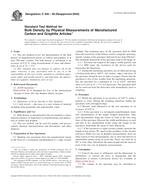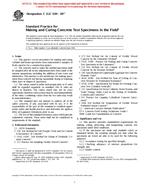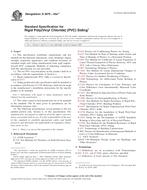1.1 This guide covers procedures for obtaining data concerning the adverse effects of a test material added to marine and estuarine waters on certain species of polychaetes during short- or long-term continuous exposure. The polychaete species used in these tests are taken from laboratory cultures and exposed to varying concentrations of a toxicant in static conditions. These procedures may be useful for conducting toxicity tests with other species of polychaetes, although modifications might be necessary.
1.2 Modifications of these procedures might be justified by special needs or circumstances. Although using appropriate procedures is more important than following prescribed procedures, the results of tests conducted using unusual procedures are not likely to be comparable to those of many other tests. Comparisons of results obtained using modified and unmodified versions of these procedures might provide useful information concerning new concepts and procedures for conducting acute, chronic, or life-cycle tests with other species of polychaetes.
1.3 These procedures are applicable to most chemicals, either individually or in formulations, commercial products, and known or unknown mixtures. With appropriate modifications, these procedures can be used to conduct these tests on factors such as temperature, salinity, and dissolved oxygen. These procedures can also be used to assess the toxicity of potentially toxic discharges such as municipal wastes, oil drilling fluids, produced water from oil well production, and other types of industrial wastes. An LC50 (medial lethal concentration) is calculated from the data generated in each acute and chronic toxicity test. Reproductive success and the number of offspring produced are used to measure the effect of a toxicant on life-cycle tests; data are analyzed statistically to indicate that concentration at which a significant difference occurs between the test solutions and control(s).
1.4 The results of acute or chronic toxicity tests with toxicants added experimentally to salt water should usually be reported in terms of an LC50. The results of life-cycle toxicity tests with toxicants added experimentally to salt water should be reported as that concentration at which a statistically significant difference in the number of offspring is produced with reference to the control(s).
1.5 This guide is arranged as follows:
Section Referenced Documents 2 Terminology 3 Summary of Guide 4 Significance and Use 5 Apparatus 6 Facilities 6.1 Construction Materials 6.2 Test Chambers 6.3 Cleaning 6.4 Acceptability 6.5 Safety Precautions 7 Dilution Water 8 Requirements 8.1 Source 8.2 Treatment 8.3 Characterization 8.4 Test Material 9 General 9.1 Stock Solution 9.2 Test Concentrations 9.3 Test Organisms 10 Species 10.1 Age 10.2 Source 10.3 Feeding 10.4 Holding 10.5 Quality 10.6 Procedure 11 Experimental Design 11.1 Acute Test 11.1.1 Chronic Test 11.1.2 Life-Cycle Test 11.1.3 Test Condition Specifications 11.2 Dissolved Oxygen 11.2.1 Temperature 11.2.2 Loading 11.2.3 Salinity 11.2.4 Light 11.2.5 Beginning the Test 11.3 Feeding 11.4 Duration of Test 11.5 Biological Data 11.6 Other Measurements 11.7 Analytical Methodology 12 Acceptability of Test 13 Calculation of Results 14 Report 15 Keywords 16 Appendixes: Neanthes arenaceodentata X1 Capitella capitata X2 Ophryotrocha diadema X3 Dinophilus gyrociliatus X4
1.6 The values stated in SI units are to be regarded as the standard.
1.7 This standard does not purport to address all of the safety concerns, if any, associated with its use. It is the responsibility of the user of this standard to establish appropriate safety and health practices and determine the applicability of regulatory limitations prior to use. Specific precautionary statements are given in Section 7.
Product Details
- Published:
- 04/10/2000
- Number of Pages:
- 22
- File Size:
- 1 file , 400 KB


